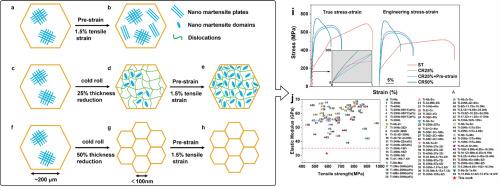通过冷轧和预应变实现近β钛合金的稳定超低弹性模量
IF 8.3
1区 材料科学
Q1 MATERIALS SCIENCE, MULTIDISCIPLINARY
引用次数: 0
摘要
在钛合金中实现超低模量以解决应力屏蔽效应一直是一个长期的挑战。近年来,尽可能增加马氏体/奥氏体界面成为降低钛弹性模量的新途径。对Ti2448的研究表明,通过预应变增加界面诱导马氏体相变确实可以获得极低的弹性模量值(< 20gpa);然而,由于马氏体相变温度较低,该模量在室温下只能持续6天才会恢复,这对于长期应用于人体是不可接受的。对具有纳米级马氏体分布的近β钛合金Ti-26Nb-4Zr-4Sn-1Mo-1Ta (wt %)进行小冷轧(减薄25%)和预应变(拉伸应变1.5%)处理。该合金的超低弹性模量为31.5 GPa,中等强度为590 MPa。冷轧形成更细、更分散的纳米马氏体域,加上预应变诱导的进一步马氏体转变,使马氏体/奥氏体界面最大化,从而导致超低弹性模量。通过这种方法得到的弹性模量在室温下可以保持一年以上。进一步的表征表明,该合金中纳米马氏体的形成是由成分因素、快速淬火(182.9±48.4 MPa)引起的内应力和ω相的抑制作用共同驱动的。这种简单可行的界面工程方法拓宽了低模量钛合金的成分设计空间,为未来生物医用钛合金的研究提供了新的思路。本文章由计算机程序翻译,如有差异,请以英文原文为准。


Achieving stable ultra-low elastic modulus in near-β titanium alloys through cold rolling and pre-strain
Achieving ultra-low modulus in titanium alloys to address the stress shielding effect has been a longstanding challenge. In recent years, increasing the martensite/austenite interfaces as much as possible has emerged as a novel approach to reducing the elastic modulus of titanium. Research on Ti2448 demonstrated that inducing martensitic transformation through pre-strain to increase the interfaces can indeed achieve extremely low elastic modulus values (<20 GPa); however, due to the low martensitic transformation temperature, this modulus only persists for 6 days at room temperature before reverting, which is unacceptable for long-term applications in the human body. In this study, minor cold rolling (25 % thickness reduction) and pre-strain (1.5 % tensile strain) were applied to a near-β titanium alloy Ti-26Nb-4Zr-4Sn-1Mo-1Ta (wt %) with nanoscale martensite distribution. An ultra-low elastic modulus of 31.5 GPa and moderate strength of 590 MPa were achieved in this alloy. The formation of finer and more dispersed nano martensitic domains due to cold rolling, along with further martensitic transformation induced by pre-strain, maximizes the martensite/austenite interface, and results in such ultra-low elastic modulus. The elastic modulus obtained through this method can be maintained for over one year at room temperature. Further characterization revealed that the formation of nanoscale martensite in this alloy is driven by a combination of compositional factors, internal stresses induced by rapid quenching (182.9 ± 48.4 MPa), and the inhibitory effect of the ω phase. This simple and feasible interface engineering method broadens the compositional design space for low modulus titanium alloys, providing new insights for future research on biomedical titanium alloys.
求助全文
通过发布文献求助,成功后即可免费获取论文全文。
去求助
来源期刊

Acta Materialia
工程技术-材料科学:综合
CiteScore
16.10
自引率
8.50%
发文量
801
审稿时长
53 days
期刊介绍:
Acta Materialia serves as a platform for publishing full-length, original papers and commissioned overviews that contribute to a profound understanding of the correlation between the processing, structure, and properties of inorganic materials. The journal seeks papers with high impact potential or those that significantly propel the field forward. The scope includes the atomic and molecular arrangements, chemical and electronic structures, and microstructure of materials, focusing on their mechanical or functional behavior across all length scales, including nanostructures.
 求助内容:
求助内容: 应助结果提醒方式:
应助结果提醒方式:


